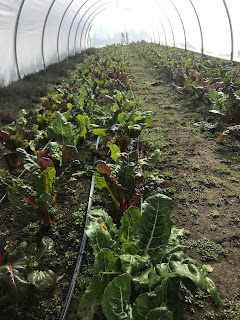5 Tips & Strategies for Winter Growing, Part I
Are you a dedicated vegetable gardener? If so, I know you thrive on growing plants.
Do you marvel at tiny seeds sprouting
and growing to vegetables? Nothing better for the soul or our stomachs!
20 years ago, I embarked on the journey of winter growing. I
wanted to extend our harvest seasons and to have vegetables over the winter. I
wanted to have early spring crops. I wanted—nature laughed!
So here are some tips and strategies based on what I have
learned (and continue to learn) about growing in the winter months. Winter is a
challenge for us here in Delaware, because our days are shorter, and the
night-time temperatures are below freezing.
Look for cold-hardy varieties that can handle the level of
protection that you can provide. Adjust your expectations of how quickly things
will grow. Supplemental heat makes a huge difference, but you have to evaluate
the cost of heating compared to what you get out of it.
Here are some strategies to start:
1. Light—as much as possible! Anything with a flower needs at least 10 hours of daylight in order to flower, pollinate, and produce. However, plants that do not flower can get by on 4-6 hours of daylight. Good thing, because the winter months are often cloudy, and the light is often diffused for much of the day.
In Delaware, where we are, we lose our 10-hour mark on November 15, and go back above 10 hours on January 26. Google knows the answer to your 10-hour marks.
So, what grows in lower light
levels? Lettuce, arugula, chard, collards, kale, mustard greens, mizuna,
spinach…you get the idea. The leafy greens. Plus, you can grow beets, carrots,
radishes, carrots, daikon, turnips. They
grow in the dark, underground, but need light to feed the top growth.
2.
Wind protection—winter winds are ferocious on
plants! Some sort of protection is necessary, keeping in mind that you want to
let in as much light as possible. You
can build a cold frame, cover with row cover, build a lean-to, use container
pots in a sun room in your house, build a mini-greenhouse with glass walls and
roof.
Anything with glass or greenhouse
plastic will amplify any sunlight and help warm the plants up during the day.
Night-time temperatures, though, can get pretty cold. Each unheated layer that
you give the plants gives you about 4 degrees of protection. If it goes down to
20, you will have 24 degrees inside your area, without supplemental heat. If you add a row cover over your plants plus
the outer cover, you have 8 degrees of protection.
 |
| Chard in an unheated tunnel |
If you have a structure up against
a house wall, it gets the benefit of residual heat from the house. Have the
structure so that you are south facing for maximum sun exposure.
It’s hard to believe, but you also need to keep in mind venting on sunny days, as it can get too warm too quickly in a little house. You will get a build-up of condensation, which drips on the plants and can cause mold. A fan, or a way to crack a door or window, is helpful to keep the air circulating and bring some fresh air into the house.
5.
Where do those aphids come from? You have seen
them appear all of a sudden on house plants or in a greenhouse. They are a
complete nuisance in a closed setting. Proper air circulation and venting help
a lot in keeping aphids out of your plants. Inspect your leaves regularly and
wash off promptly. We use a peppermint solution which helps if those pesky
critters show up. We also have fans which run 24/7 in our tunnels.
This is a lot of information to take in, and there is more
to come. Visit us at our farm market at 1431 Foulk Road, Wilmington, Delaware,
to see what we are growing all winter. Follow us on Facebook @highlandorchards
and Instagram @highland_orchards for behind-the-scenes views of what we are
doing. Feel free to email with questions or comments to
highlandorchards@msn.com. Part II, with
5 more tips will be coming soon. Thank you for being part of the growing
community!



Comments
Post a Comment